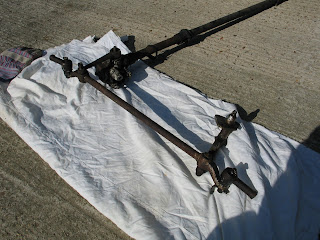The new dampers arrived but two problems became obvious immediately. Firstly, the loop-to-loop dimension was incorrect and the dampers would, if fitted, have lowered the car. Secondly, the original damper springs did not fit onto the new dampers. The solution was to return the dampers for replacement with ones of correct length and also to have appropriate springs fitted by the damper supplier. This meant supplying a front and rear spring as samples for spring compression rate verification because, although the original kit assembly instructions specified which two of the four shock absorbers were to be fitted to the back axle, information on other aspects of the damper/spring assembly were, unfortunately, never supplied.
When the springs were removed, it was found that those for the rear axle were 0.5 inch longer than those for the front suspension - not a serious problem apparently, but something unexpected and without a known reason. It seems that there was a connection between the different lengths and specifying which units were to be fitted to the rear axle!
When the front brake shoes were delivered, they were the wrong size (incorrect information used) and so the old metals had to be re-lined - more expensive than new shoes!
On the rear trailing arms, all the rubber in the bushes had perished but it was possible to obtain over-length bushes of the correct internal and external diameters and to have them reduced in length before being pressed into the arms.
The replacements for the corroded outriggers and sidebars on the chassis were obtained from the Club Registrar so that work could start on repairing the chassis. However, as all of the above problems coincided with the arrival of our son and his family on holiday from New Zealand, serious doubts about the planned project completion date began to emerge.
 |
| The chassis had multiple corroded areas - the front outriggers, the siderails, the rear outriggers and a section of the angle-iron holding the upper loop of the O/S front shock absorber. |
The chassis was prepared for collection by the welder but in order for an effective removal of rust to allow for repairs, all the old underseal had to be removed beforehand using an electric paint stripper and scraper - a long and dirty job for which the only saving grace was that the greater part of the chassis metalwork had been protected over the years.
After the collection of the chassis came the opportunity to start refurbishing activities and as all the relevant parts were available, a start was made with the cleaning and painting of the back axle (Standard 10 in origin) and the fitting of new slave cylinders, dust covers and brake shoes.
 |
| Note the photo of the brake drum details prior to disassembly - important if it is likely that a delay will occur before reassembly. |
From a contact in The Standard Motor Club, details of a firm that supply replacement bushes for the steering idler link were obtained - rubber is not used in the bushes and a longer life is claimed. The contact also offered to provide the use of a flypress to insert the new bushes - an offer that could not be ignored.
Things are now starting to happen but August 15th, the date of the Fairthorpe Gathering, marking the 50th anniversary of the founding of the Club, is less than one week away and although the repaired and painted chassis has now been returned, there is no chance of getting very much replaced before then.






